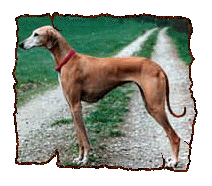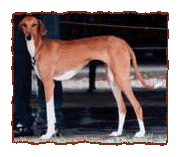|
| |
Azawakh Breed Information
and FCI Breed Standard

Al Hara's Cida

What kind of dog is that?
Do they all look like that?
Where do they come from?
Can they be shown?
What are their temperaments like?
How do they do with children?
What about other pets?
Can they race or lure course?
Is there a breed club for
Azawakhs in the U.S.?

Kel Simoon Essari
(Amastan Kel Air X Kel Simoon Cinnamon)

What kind of dog is that?
The elegant, graceful animal you are inquiring about is an Azawakh (pronounced
Oz-a-wok). It is a unique type of sighthound that is also an impressive guard dog
Back to top

Do they all look like that?
Azawakhs are elegant, tall dogs of proud bearing. Lean and muscular of frame,
their appearance should indicate swiftness when running. He should be longer of leg than
of body, which may seem extreme when compared with other sighthounds His neck is long and
graceful, his head held high when alert. His tail is proudly carried above the line of the
back. The breed has pendant ears which are raised to the side of the head in response to
sounds. Their movement is spectacular to watch. At the trot, they are light and graceful;
at the gallop, they cover ground in great strides Males range from 25-29 inches in height,
females, 23 1/2 - 27 1/2 inches. The short, smooth coat comes in a variety of colors to
include, clear sand to dark red, white, black, blue, gray, brindle, grizzle, parti-color
and all shades of brown including chocolate. The overall impression is that of speed,
power and majesty.
Back to top

Where do they come from?
Because their discovery by the "dog fancy" has been so recent, it
is easy to trace their migration to America. An African sighthound, the breed originated
in Mali, Niger and Burkina Faso. Raised in the Sahel region of the Sahara desert, they are
named for the Azawakh valley. Azawakh means "land of the north". They are the
guardians, hunters and companions of the Tuareg and other ethnic tribes of the southern
Sahel. The breed was first imported to Yugoslavia in the early 1970's by Dr Picar, a
Yugoslavian diplomat stationed in Burkina Faso. The dogs could not be bought, however, Dr
Picar received his male as a gift from the nomads. He later bartered his services as a
hunter, by killing a bull elephant who had been terrorizing the tribe, in exchange for a
female Azawakh. The French military and civil servants also played a significant role in
exporting the Azawakhs to Europe.
The Azawakh made it's debut in America in the mid 1980's. The first litter was whelped on
October 31, 1987. These first American Azawakhs were all red or fawn with white markings.
The first brindles came to America in 1989, with the first brindle litter whelped November
27, 1990. In the mid 90's, a parti-color male was imported from Burkina Faso and in 1997,
a mixed parti-color and sand litter which was bred in Mali, was whelped in Alaska. It is
hoped that an even larger selection of colors will find their way to the U.S. from Africa
in the near future.
Back to top

Can they be shown?
The Azawakh has a show history that begins very soon after its original
importation. They were first shown in the early 1970's under FCI rules as a variety of
Sloughis. On January 1, 1981, they were accepted as a bonafide breed and were referred to
as "Sloughi-Azawakhs". In 1986, the Azawakh was finally recognized for the
unique animal it is, when FCI dropped the word "Sloughi" from the name. In
America, the Azawakh is recognized by the United Kennel Club (UKC), the International All
Breed Kennel Club of America (IABKCA), the American Rare Breed Association and many other
smaller registries. The American Azawakh Association is the parent club for the breed in
the US. Although the AAA doesn’t recognize the FCI Standard for the breed because of
its color limitations, the dogs can be shown in any FCI recognized country under FCI rules
which allow only cream to red and brindle, with all other colors disqualified. Their
history as show dogs is in its infancy, but their natural regal presence demands
recognition.
Back to top

What are their temperaments like?
When discussing the temperament of an Azawakh, consideration should be given
to individual personalities and contributing backgrounds, both genetic and environmental.
However, there are several general characteristics common to the breed. Described in Dog
World as a "warrior class dog" and by a new puppy owner as a "Basenji on
stilts", they have the intelligence and heart to protect. When approached on his own
turf, he is very vocally intimidating. In situations where their duty as guardian isn't
necessary, their reactions may range from friendly, to mildly curious to arrogantly
indifferent Although generally not outgoing, several in the US have found the opportunity
to make social contributions as therapy dogs in nursing homes and rehabilitation centers
They seem to possess an uncanny combination of total loyalty and independance. Each new
situation presents the potential for the struggle between the dog's natural desire to
please and his prideful desire to do things his own way. A firm, fair hand is called for.
Properly socialized and trained, the Azawakh will live harmoniously within the family and
community
Back to top

How do they do with children?
No one can predict the individual personalities of all dogs in any breed
There are some situations which should be avoided with guard dogs of any breed. Children
playing together sometimes squabble. It is natural for a guard dog to protect
"his" children from their playmates. Azawakhs, being spirited family
participants, freely volunteer their assistance when another family member is being
disciplined. This unexpected "assistance" can be frightening for everyone. There
are individual dogs of all breeds which do not like children. The Azawakh, as a breed,
with care given to the situations mentioned, should fit well into any family structure.
Back to top

What about other pets?
Much discussion as been given to the guardiness of the Azawakh, but here we
must remember that this is a sighthound. As a rule, they seem to accept other dogs, though
sometimes grudgingly, as protected members of their own pack. Many less "gamey"
dogs do well with an indoor cat, however, bets should not be placed on the chances of a
cat in the yard or the neighbor's Pomeranian. Because comparatively few generations have
been removed from the need to hunt daily for personal and family survival, the hunting
instinct is very strong in this breed
Another point to mention is that the Azawakh is a very dominant breed. Within a household
pack, they will almost always aspire to the alpha dog position. If there is an existing
dominant dog in the pack, this can sometimes cause conflict within the pack.
Back to top

Can they race or lure course?
The present status of the Azawakh in America is a source of frustration for
owners interested in lure coursing. The breed is extensively coursed and raced in other
countries, however, in the U.S they are not officially recognized by the American
Sighthound Field Association (ASFA). Since 1996, the breed has been able to lure course
under the auspices of the ASFA in the Miscellaneous Stake. However, the Miscellaneous
Stake is unable to compete for Best of Breed and Best in Field. Points towards a Field
Championship are not tabulated by ASFA and Field Championships are not awarded to breeds
running in the Miscellaneous Stake. It is the hope that by the year 2000, the breed will
be fully recognized by ASFA and will be allowed to compete in regular stakes for it's
breed.The Azawakh is recognized by the National Open Field Coursing Association (NOFCA)
for open field coursing in the midwest portion of the US as a rare breed.
There have also been supportive offers made by some National Oval Track Racing Association
(NOTRA) members.
Back to top

Is there a breed club
for Azawakhs in the U.S.?
The American Azawakh Association, Inc. (AAA) is the parent club for the
Azawakh. The AAA was founded on February 7, 1988 with the goals of promoting the pure
Azawakh and guaranteeing the breed a permanent future in the U.S. Further information may
be obtained by writing to the American Azawakh Association, 305 Wild Horse Creek Rd.
Wildwood, MO 63005. The club publishes a quarterly newsletter, The Azawakh Aegis, which is
available by subscription to interested persons.
Back to top
|